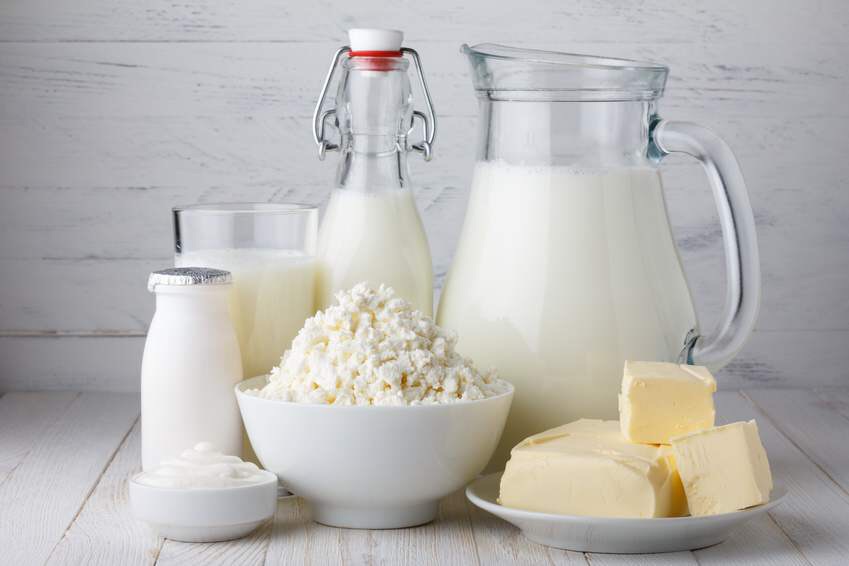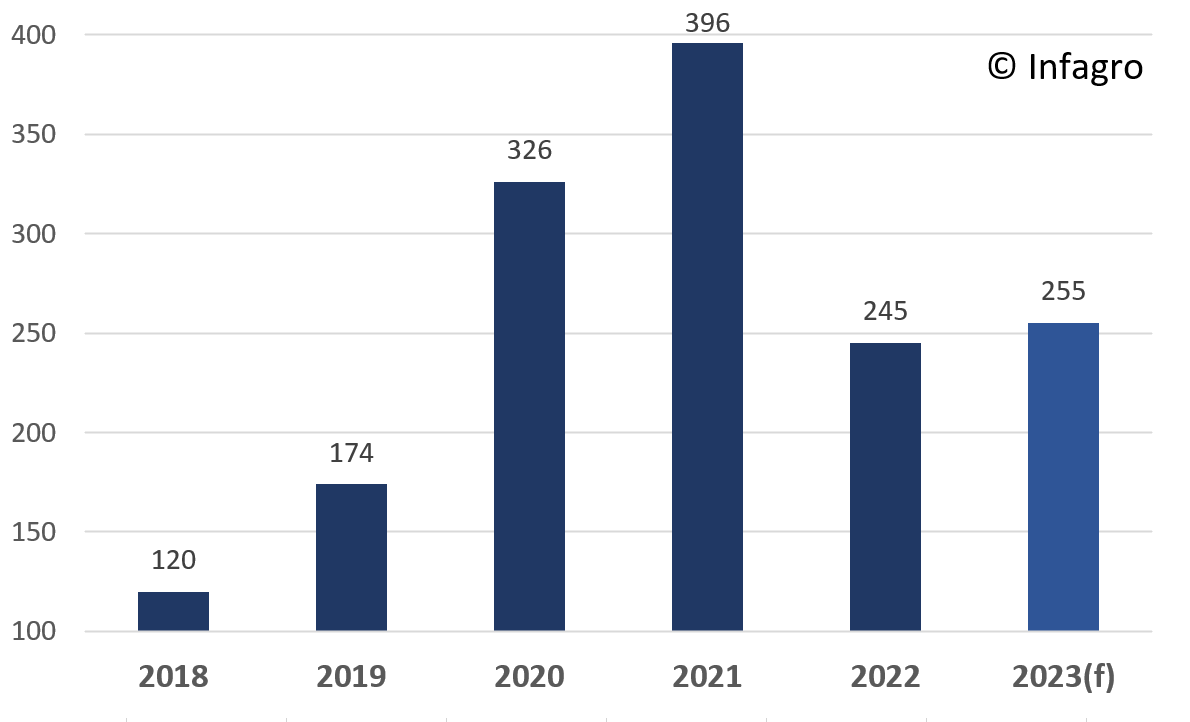The growth of milk imports was stopped by the war

The war slowed down the dairy imports
Due to the old habit, Ukraine is still often called a powerful world dairy exporting country. Not so long ago, such a definition was relevant. In the middle of zero years, the volume of annual exports reached 2.5 million tons in milk equivalent. Then there followed a significant drop, but even 6 years ago Ukrainian dairy exports still exceeded 1 million tons.
In recent years, the dairy balance in the country has dramatically changed. Milk production was steadily decreasing and consumption was growing. In the pre-war year 2021 milk production was barely enough to meet domestic needs. But there was still export, and to ensure the balance it was necessary to purchase practically the same amount of dairy products in milk equivalent as it was exported. That is, for the only period from 2018 to 2021, the volume of imports increased 6 times, to approximately 0.6 million tons.

Fig. 1. Dynamics of imports of dairy products in 2018-2022 in milk equivalent, million tons

Fig. 2. Dynamics of imports of dairy products in 2018-2022 in monetary terms, million dollars.
Apart from the shortage of milk supply, the assortment policy of domestic milk producers was also the factor that caused the growth in the volume of imports. They could not always offer a wide range of cheeses or fresh dairy products, which were in demand among Ukrainians who were becoming more solvent. As a result, exported were dairy commodities, and imported were added value dairy products aimed at consumption by the final consumer. Therefore, in monetary terms, the growth of imports became more significant, and in 2021 it exceeded exports by 9%.
The price factor also contributed to the increase in the volume of imports. In the EU countries, which are the main suppliers in Ukraine, prices for dairy products were lower than those offered by domestic producers. There were several reasons for this. As a rule, the European dairies are better equipped technologically, and therefore their production cost is lower compared to that of Ukrainian processors. Also, in 2021 purchase prices for raw milk in the EU countries were lower than those in Ukraine. Europe also has a stable financial system, money is cheaper, so the European dairies have a lower profit margin than in Ukraine, earning on volumes.
In 2022 the full-scale invasion of russia led to extremely negative changes in the dairy balance of Ukraine. This was also reflected in imports. In the first months of the war, almost all foreign suppliers left the market of the warring country. Apart from security factors, their decision was affected by logistical problems. In general, against the background of rising prices of dairy products in Europe, their import into Ukraine has become simply unprofitable from the point of view of business profitability. In 2022, for a long time, Ukrainian milk was a third cheaper than in neighboring European countries. According to the results of 2022, the volume of imports of dairy products in milk equivalent decreased by half to the level of about 300,000 tons, and in monetary terms by almost 40% to 245 million tons.
In the current year, the import of dairy products will get increased, but not significantly. And from the medium-term perspective, foreign purchases will be increasing. As Ukrainians will be coming back home, dairy consumption will be growing, but dairy production will not be capable to adequately increase production as there will be not enough raw milk available.
Cheese
The core volume of dairy products imported into Ukraine is a wide range of cheeses. Ukrainian manufacturers see the biggest threat in the import of this product because not so long ago they could not withstand the competition and were steadily losing sales in their own market. For example, in 2021, the share of imported products in the sales structure of hard/semi-hard cheeses exceeded 30%. The sale of various European soft and brine-ripened cheeses accounted for more than half of the total volume.
In 2021, there were 48,000 tons of cheese were imported to Ukraine. In 2022 due to the war and changes in the market situation, foreign purchases of this product decreased by 36% to 31 thousand tons. Starting in 2023, the import of cheese began to recover and in a few years it may surpass the record of 2021.
Traditionally, Ukraine imported the elite cheeses the choice of which was supply limited in the country. But in recent years, the growth in imports occurred due to the imports of mass-produced cheeses. Trade chains earn more on these cheeses rather than on Ukrainian counterparts due to lower purchase prices. A range of the most common semi-hard cheeses are imported to Ukraine in large quantities, as well as a variety of soft and brine-ripened cheeses, which are also called “white cheeses”. Such products are supplied both for retail (Camembert, Brie…) and for HoReCa (Mozzarella, grated cheese…). Processed cheeses of both well-known and not-so-well-known brands are also supplied to Ukraine in significant volumes.
Fresh dairy products
Before the war, purchases of fresh dairy products were steadily growing. In this product category, domestic manufacturers did not see a big threat, since their sales were not even reaching 5% in the structure of total sales. In 2021, 35 thousand tons of fresh products were imported into the country.
In the structure of import of fresh dairy products prevailing are a variety of yogurts, cheese products, and desserts. But sometimes import of ordinary ultra-pasteurized milk has also been profitable.
In 2022, the import of fresh dairy products decreased by 35% to 23,000 tons. In the current year, there will be no significant growth in external purchases of these products, but an increase is possible starting next year.
Butter
In addition to cheeses and fresh dairy products, Ukrainian operators have repeatedly practiced importing butter. This occurred in the periods when butter in Ukraine was more expensive than in Europe. For example, in 2020-21, external purchases of butter were not much smaller than sales. During these years, almost 8 and 7 thousand tons were imported, respectively. In 2022, the import of butter was unprofitable, and it will not be purchased abroad this year either.
Milk powder and baby food
Despite the fact that Ukraine is considered a major exporter of dry milk and whey, there were periods when it was profitable to import these products to Ukraine. In the 2022 year, this business was irrelevant, in 2023 milk powder will not be purchased either, and own milk powder nowhere to go.
The import of dry mixtures for baby food is also stable since there is only one manufacturer of such products in Ukraine. About 1.2 thousand tons of the mixtures are imported into Ukraine every year, and 2022 was no exception. Also, in small quantities, various protein concentrates and lactose are purchased from abroad, that is the products that are not produced in Ukraine.
Geography of imports
Historically, almost all dairy products are imported from EU countries. It is geographically close, the logistics are simple, and the range of dairy products in Europe is quite wide. The prices are also affordable for Ukrainian consumers. In the pre-war year 2021, 90% of all imports came from EU countries, in 2022 there was 98%.
Before the war, belarus actively tried to enter the Ukrainian dairy market. There were deliveries of canned milk, attempts of selling fresh milk products were also made and from time to time Ukraine also purchased dry milk products from belarus. Of course, such cooperation has been cut and it is unclear when belarusian dairy products may appear on the shelves of Ukrainian stores again.
Small quantities of dairy products were purchased in Great Britain, Switzerland, and Canada. At one time, fairly large volumes of butter and milk fat were imported to Ukraine even from far away New Zealand and the USA. It looks a little strange, but there were periods when butter in Ukraine and Europe was very expensive and such imports were profitable.
Among the EU countries, producers from neighboring Poland show the greatest interest in the Ukrainian market, which, by the way, recently tried to ban the import of Ukrainian agricultural products, including dairy. In 2021, Poland accounted for 36% of total dairy imports in monetary terms, and in 2022, 48%. Moreover, the Poles are leading in the supply of almost all categories of dairy products. Producers (mostly cheese makers) from Germany, The Netherlands, France, and Italy are also not indifferent to the Ukrainian market.
In the future, the expansion of the geography of imports is unlikely. For suppliers from EU countries, Ukraine has much more attractive conditions than other regions, since there have been no quotas or duties for most goods for supply to Ukraine for a long time. For Ukrainian suppliers to Europe, such preferences appeared only last year and, unfortunately, only because of the war. We would like to believe that in the future imports will not be significant and domestic manufacturers will eventually be able to offer Ukrainian consumers a wide range of high-quality products cheaper than imported counterparts.
Read also
Wheat in Southern Brazil Impacted by Dry Weather and Frosts
Oilseed Industry. Leaders and Strategies in the Times of a Great Change
Black Sea & Danube Region: Oilseed and Vegoil Markets Within Ongoing Transfor...
Serbia. The drought will cause extremely high losses for farmers this year
2023/24 Safrinha Corn in Brazil 91% Harvested
Write to us
Our manager will contact you soon



